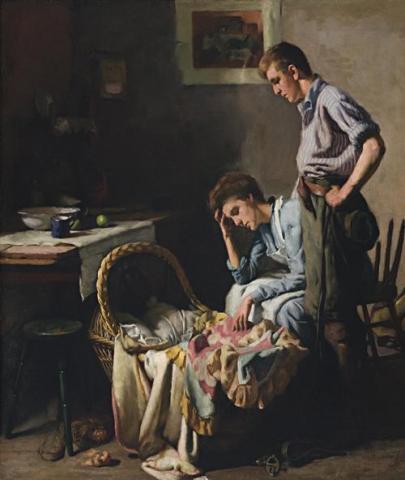THE EMPTY CRADLE, 1908
W.B. Mcinnes
oil on canvas
146.0 x 127.0 cm
Sir Marcus Clark, Sydney
The Estate of Pro Hart, Broken Hill, New South Wales
W.B. McInnes Memorial Loan Exhibition, Art Gallery of New South Wales, Sydney, 2 September – 14 October 1940, cat. 62, lent by Sir Marcus Clark K.B.E.
Colquhoun, A., The Work of W. Beckwith McInnes, Alexander McCubbin, Melbourne, 1920, n.p.
Peers, J., 'National Gallery of Victoria Travelling Scholarship, Melbourne 1908', in Kerr, J., ed., Heritage: The National Women's Art Book, Craftsman House, Sydney, 1995
William Beckwith McInnes is best known as the painter of the settled Australian landscape, of farming scenes and sunlit skies. He seldom ventured into the narrative, even Country Boy and Town Girl, formerly in the Foster's Collection of Australian Art, being more about the trusty Clydesdales in the farmyard than any amorous human dialogue. Haywagons were more his metier than motherhood, with one important exception, this painting. A student at the Melbourne National Gallery School, in 1908 he entered The Empty Cradle for the Travelling Scholarship, his choice of subject no doubt being influenced by the success of such works of pathos in the past. In 1887 John Longstaff won the first Scholarship with Breaking the News, a painting devoted to the tragic news brought to the young mother that her husband had been killed in a goldmining accident. It was acclaimed as 'the greatest picture of the year'1 The next winner was Aby Alston, who, in 1890, won the scholarship with Flood Sufferings - of a young mother and her babe being taken from their flooded house by stretcher. Pathos seemed a sure winner. The writer for The Australasian Critic observed, 'A strong prejudice prevails in Australia in favour of pictures describing local incidents or characters - a prejudice which future contestants for the scholarship would de well to bear in mind.'2 McInnes obviously took note.
The predecessors of this kind of narrative were those large and loved Victorian paintings such as The Mitherless Bairn by Thomas Faed, a big success at the Royal Academy in 1855 and purchased by the National Gallery of Victoria in 1886; and Homeless by Thomas Kennington, purchased by the Bendigo Art Gallery in 1906. In Australia, the genre was worked on with much success by artists from Robert Dowling to Frederick McCubbin. Although McInnes 'made a good bid for it', the scholarship was won by Miss Constance Jenkins' anecdotal Friendly Critics. Nevertheless, McInnes had his admirers. Alexander Colquhoun being moved to write, 'The picture, conceived in that spirit of domestic pathos which finds expression most readily in the young and untried imagination, was well painted, and achieved much popularity as a coloured supplement to a Melbourne weekly paper.'3
1. Clark, J. & Whitelaw, B., Golden Summers: Heidelberg and Beyond, International Cultural Corporation of Australia Limited, Sydney, 1985, p. 47
2. Clark, op.cit, p. 48
3 Colquhoun, op.cit, n.p.
DAVID THOMAS
